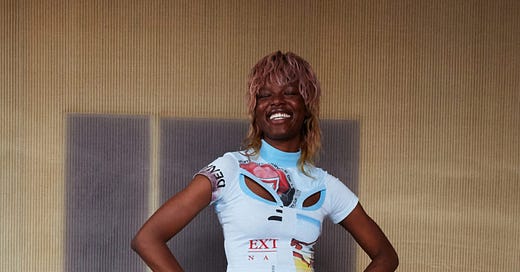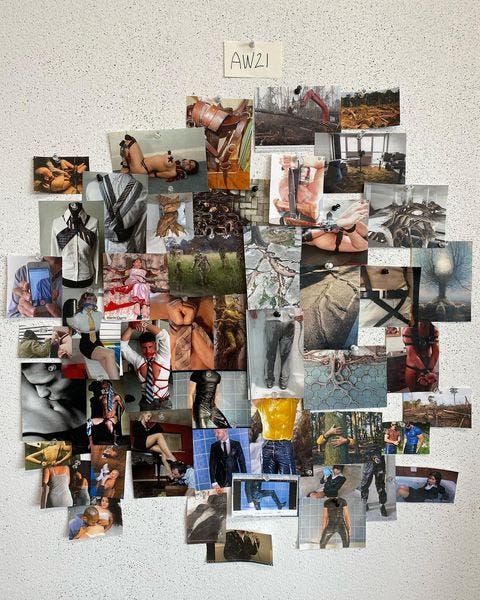It's Sweet Like Juice
Montreal designer Lafaille's AW21 collection explores both fetish and forces of nature
Thanks for reading Lili. Some housekeeping: I start grad school this September, and so I will have less time to write. I am committed to continuing to publish Lili as often as possible, ideally twice a month going forward. Thank you for your patience.
xoxo Marc
One of the most interesting things that fashion can do is create and shape desire through clothing. We have all seen a little black dress that has set our brains ablaze. If you have not, I pity you. The good news is that we have never had more sources and forms of desire available and acceptable to choose from. In a world where WAP went sextuple platinum, and where people tweet constantly about wanting to be choked, spat on, and stepped on, we are primed for an exploration of every sort of fetish and kink.
Montreal designer Benjamin Lafaille seems deeply aware of this. For his Autumn/Winter 21 collection, Lafaille, designing for his namesake label, released a collection of 13 looks that used every sort of fetish as a launchpad to explore the relationship between “human impulse and the force of nature.” The collection, titled “Ego vs. Eco” explores how “Everything we, as humans, have pushed onto the planet has been projected back onto us as a form of karma and self reparation”, as per the show notes.
Deconstruction features heavily in every Lafaille collection, and AW 21 is no different. Look 10 of the collection demonstrates this beautifully through a skirt made of upcycled ties. Ties are obviously loaded with sexual potential, being phallic cuts of fabric, worn around the neck and intended to point to your loins.
Naturally, they have been used time and time again in sexual scenes for blindfolding and for bondage. But the skirt here is cavernous, not constrictive, with the different ties giving the effect of a trophy collection, as if each tie was plucked off some conquest.
Similarly playing on the theme of constriction is the “Baltenum” skirt featured in Look 1, made from upcycled black denim, with a leather belt running down the skirt. It seems the belt is frozen in time, mid-cascade to the floor. The top is made from upcycled dress shirts and uses the collars of said shirts to highlight the bust. Lafaille clearly isn’t afraid to play the hits when it comes to exploring desire.
The idea of forces of nature is most apparent in the collections’ “soaked” looks, where clever darting1 and varnish are applied to garments to make them shine and cling to the body in the way that gets wet clothes fetishists2 going. The garments also look as though the models have been caught in a sudden downpour. The rain this summer in Montreal has been capricious, and I myself have been caught in some unforeseen torrents. There’s something deeply humbling about the way the sky just opens, instantly soaking you to the skin. The rain once caught me on my bike, totally eliminating my ability to see the road, and forcing me to take cover in the awning of a dep. Standing there with my clothes stuck to my body like a second skin, I could do nothing until the weather permitted me to pass.
Lafaille’s understanding of nature’s power perhaps motivates the prominence of upcycling in AW21. Of the 13 looks presented in the collection, all but 4 are totally upcycled. In light of our imminent climate disaster, the fashion world is tripping over itself to incorporate upcycling and other sustainable initiatives. However, as with all such initiatives, we must remain vigilant against empty words. Lafaille means it. The upcycling here is beautiful, used to make wearable3 garments, and serves a true artistic purpose.
In fact, the upcycling in the collection is perhaps the most literal manifestation of the show’s theme of our desires being pushed back upon us. The “Sway” dress featured in Look 5 is stunning, but one is deeply aware that several shirts that were once garments in their own right are now only parts of one whole. The shirts persist in memory to their original owners, and here they persist in simple material. It feels almost reductive. But such is the nature of desire: you’ve ruined your sheets and now you have to upcycle them.
Darts are conical folds sewn into clothing to manipulate shape and silhouette. They are most commonly used in dressmaking to accommodate breasts.
wetishists.
Life is already so hard, can’t I at least look good while I suffer?









